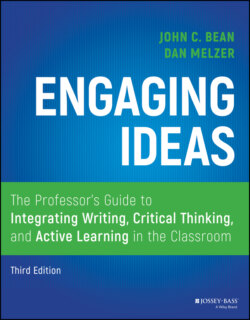Читать книгу Engaging Ideas - John C. Bean - Страница 75
Different Genres Tap Different Kinds of Strengths, Allowing More Students to Succeed
ОглавлениеAnother benefit of assigning different genres—especially mixing academic with more personal or creative forms—is that it draws out different kinds of strengths from students. Often students do their best work when instructional methods and assignments match the way they like to learn. Although learning style research has lost some of its popularity from its heyday in the 1980s and 1990s, the research reveals important differences in the ways students approach writing tasks.
For example, Jensen and DiTiberio (1989) used the Myers‐Briggs inventory to reveal different assignment preferences among writers. Along the Myers‐Briggs thinking/feeling continuum, they found that “thinkers” excel at writing logical, well‐organized essays requiring analysis and argumentation. By contrast, “feelers” prefer assignments that allow for personal voice, conviction, and emotion. They are unlikely to be motivated by an assignment unless they can relate to it personally, and they are attuned to a reader's desire for lively, interesting prose. They like to put their own personal experiences into a paper and often prefer autobiographical or narrative approaches rather than an abstractly reasoned approach.
Differences across other continua reveal other insights that are helpful to teachers when designing assignments. “Sensing” types, for example, want writing assignments with very detailed instructions and guidelines and find comfort in teacher‐prescribed organizational patterns such as the “five‐paragraph theme.” By contrast, “intuitive” types rebel against prescribed patterns and like looser assignments that give them room for their own unique or creative personal touches. Along the perceiving/judging scale, “judgers” tend to arrive quickly at a thesis and are often bored with personal exploratory writing such as journals, which they dismiss as “busywork.” By contrast, “perceivers” like to play with ideas endlessly, have trouble deciding on a thesis, and will explore ideas forever in their journals unless a deadline forces them to quit. Finally, along the extrovert/introvert continuum, “extroverts” prefer to explore ideas through class discussions or small groups, whereas “introverts” like solitude, preferring a journal for exploration rather than group conversation.
Jensen and DiTiberio's research suggests that some students are apt to do their best work within closed‐form, academic genres, whereas others will do best on open‐form, more personal, or creative writing tasks. Students who rush to closure might benefit from low‐stakes exploratory writing that encourages them to explore all sides of an issue. Students who feel stifled by “rules” might profit from explanations that rules are often constraints imposed by genres rather than by the idiosyncrasy of the teacher. By asking students to write in several different genres or styles, teachers give students more opportunity to find one or two that are particularly effective for them; likewise, students get to discover that they can learn significantly from doing an assignment that is not, by nature, their preferable way of operating.
